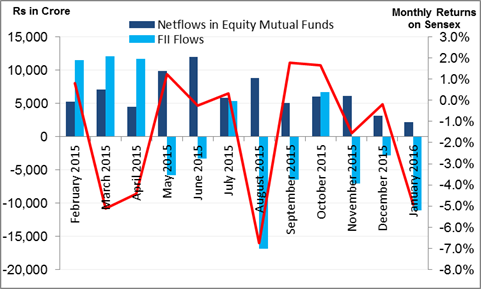Acrophobic people (those who have a fear of heights) are uncomfortable riding on a Ferris wheel. Their tour to an amusement park can sometimes turn into misery. It’s almost impossible for them to look down from the highest point. Sharp and skiddy rotations of the wheel make them feel nauseous. Fortunately, acrophobia is curable. Some experts believe that gradually exposing acrophobic people to heights may help alleviate their fear.
PersonalFN can’t help acrophobic patients effectively deal with panic situations but it can definitely help investors develop a coping mechanism to deal with market havocs.
Similarly, retail investors are also averse to sharp and skiddy movements but they are never afraid of heights. In fact, they always want to touch the sky; unfortunately it is almost always too high for them. And contrary to persons who suffer from acrophobia, they panic when markets are on their downward spiral.
Foreign Institutional Investors (FIIs) are the trend setters in Indian markets while domestic retail investors are followers. It’s observed that retail investors often keep distance from falling markets. They re-enter the game when there’s too much of a struggle for too little.
Losing Hope?

Data as on January 31, 2016
(ACE MF, AMFI, PersonalFN Research)
In January 2016, the Indian bellwether index S&P BSE Sensex lost 4.9% as FIIs pulled out about Rs 11,100 crore from Indian markets. At Rs 2,128 crore in January, inflows in equity mutual funds were at their lowest since April 2014.
Inflows in equity funds reflect the sentiment of retail investors. When investors are bearish, mutual funds receive lower inflows and vice-versa.
Since the onset of 2015, the memories of watershed victory of NDA Government were fresh. Returns generated by the markets in the immediate past were extremely impressive and encouraging. Riding the momentum, retail investors made a beeline for the Indian markets. But sooner, rather than later, the honeymoon period of the NDA Government ended. Expectations did not transform into reality. Corporate profits stayed stagnant and reforms got overshadowed by the intolerance debate.
It seems smaller cities had high expectations this time. Their participation in equity markets rose quite remarkably in 2015. In the recent times, the contribution of the retail investors in smaller cities (beyond top 15 cities) has been about 1/3rd of the net investments in equity mutual funds.
Changing times
In August 2015, FIIs turned extremely bearish on Indian markets; perhaps the party was over. However, complacency hit the retail investors and greed had overthrown their sensibilities and this continued until December 2015. Inflow in mutual funds has saved markets so far, but it seems even retail investors have become pessimistic about the economy’s prospects. Gloom has slowly started replacing the boom.
On a global level, factors such as fears of slowdown in China, rising U.S.$, massive fall in emerging market currencies, and sharp cuts in crude oil prices, among others have negatively affected investors’ sentiments. At present, the Indian markets aren’t resilient enough to withstand the on-going rout in the global equity markets; their fundamentals are still weak.
How to deal with panicky situations such as these? PersonalFN shares 7 secrets
- Always invest in equity markets; directly or through mutual funds, but only after considering your financial goals
- Invest for the long term and be realistic with the expected return
- Avoid timing the markets
- Do not sell your holdings simply because some experts believe that markets will fall. Even they may be unaware when the markets will bounce back
- Invest more when valuations are reasonable or low. (within confines of pre-determined asset allocation plan)
- When the valuations are expensive or high, avoid investing a lump sum. It is preferable to invest a piecemeal at a time through Systematic Investment Plans (SIP) instead.
- Ignore performance record of a mutual fund from the immediate past. Focus on the consistency and risk-adjusted returns under various market conditions.
Many of the above discussed remedies may sound repetitive and run-of-the-mill; but they are not. Let’s not forget what Paul Samuelsson famously said, “Investing should be more like watching paint dry or watching grass grow. If you want excitement, take $800, and go to Las Vegas.”
Serious investment is essentially slow and steady. If you want a thrill, take a ride on the Ferris wheel.
Add Comments